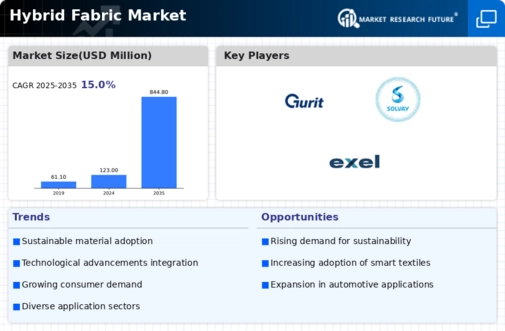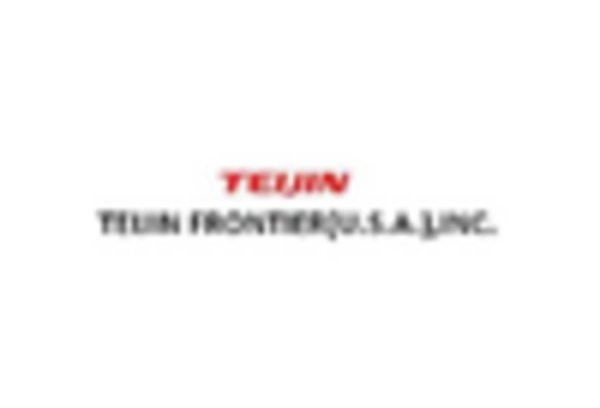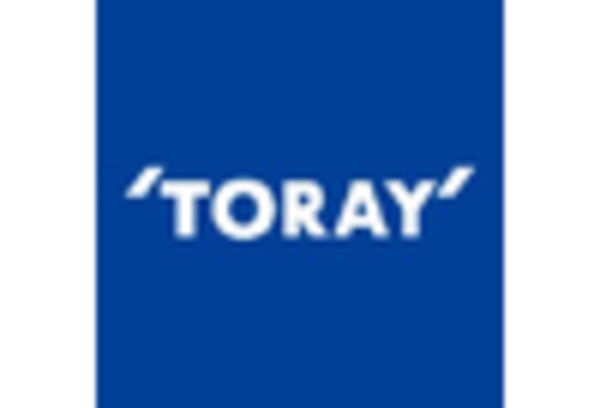-
Executive Summary
-
Scope of the Report
-
Market Definition
-
Scope of the Study
-
List of Assumptions
-
Markets Structure
-
Market Research Methodology
-
Research
-
Process
-
Primary Research
-
Secondary Research
-
Market Size
-
Estimation
-
Forecast Model
-
Market Factor Analysis
-
Supply
- Raw Material Suppliers
- Manufacturers/Producers
- Distributors/Retailers/Wholesalers/E-Commerce Merchants
- End
-
Chain Analysis
-
Users
-
Porter’s Five Forces Model
- Threat of New Entrants
- Intensity of Competitive Rivalry
- Threat of Substitutes
- Bargaining Power of Suppliers
- Bargaining Power of Buyers
-
Market Dynamics of Global Hybrid Fabrics Market
-
Introduction
-
Drivers
-
Restraints
-
Opportunities
-
Challenges
-
Global Hybrid Fabrics Market, by Combination
-
Introduction
-
Carbon-Aramid
- Market Estimates & Forecast, 2020-2027
- Market Estimates &
-
Forecast, by Region, 2020-2027
-
Aramid-Glass
- Market Estimates
- Market Estimates & Forecast, by Region,
-
& Forecast, 2020-2027
-
Carbon-Glass
- Market Estimates & Forecast, 2020-2027
- Market Estimates & Forecast, by Region, 2020-2027
-
Carbon-UHMWPE
- Market Estimates & Forecast, 2020-2027
- Market Estimates &
-
Forecast, by Region, 2020-2027
-
Others
- Market Estimates &
- Market Estimates & Forecast, by Region, 2020-2027
-
Forecast, 2020-2027
-
Global Hybrid Fabrics Market, by Form
-
Introduction
-
Composite
- Market Estimates & Forecast, 2020-2027
- Market Estimates &
-
Forecast, by Region, 2020-2027
-
Non-Composite
- Market Estimates
- Market Estimates & Forecast, by Region,
-
& Forecast, 2020-2027
-
Global Hybrid Fabrics Market, by End-Use Industry
-
Introduction
-
Automotive
- Market Estimates & Forecast, 2020-2027
-
Market Estimates & Forecast, by Region, 2020-2027
-
Aerospace & Defense
- Market Estimates & Forecast, 2020-2027
- Market Estimates &
-
Forecast, by Region, 2020-2027
-
Wind Energy
- Market Estimates
- Market Estimates & Forecast, by Region,
-
& Forecast, 2020-2027
-
Consumer Goods
- Market Estimates & Forecast, 2020-2027
- Market Estimates & Forecast, by Region, 2020-2027
-
Sports &
- Market Estimates & Forecast, 2020-2027
- Market
-
Leisure
-
Estimates & Forecast, by Region, 2020-2027
-
Others
- Market
- Market Estimates & Forecast,
-
Estimates & Forecast, 2020-2027
-
by Region, 2020-2027
-
Global Hybrid Fabrics Market, by Region
-
Introduction
-
North America
- Market Estimates & Forecast, 2020-2027
-
Market Estimates & Forecast, by Combination, 2020-2027
-
& Forecast, by Form, 2020-2027
-
End-Use Industry, 2020-2027
-
Estimates & Forecast, by End-Use Industry, 2020-2027
-
Market Estimates & Forecast, 2020-2027
-
by Combination, 2020-2027
-
Estimates & Forecast, by Combination, 2020-2027
-
& Forecast, by Form, 2020-2027
-
End-Use Industry, 2020-2027
-
Forecast, 2020-2027
-
Market Estimates
-
Market Estimates & Forecast, by
-
US
-
Market Estimates & Forecast,
-
Market Estimates & Forecast, by Combination 2020-2027
-
Market Estimates & Forecast, by Form, 2020-2027
-
Market
-
Canada
-
Market Estimates & Forecast,
-
Market Estimates & Forecast, by Form,
-
Market Estimates & Forecast, by End-Use Industry, 2020-2027
-
Europe
- Market Estimates & Forecast, 2020-2027
- Market
- Market Estimates
- Market Estimates & Forecast, by
- Germany
-
Market Estimates & Forecast, by End-Use Industry, 2020-2027
-
& Forecast, by Combination, 2020-2027
-
by Form, 2020-2027
-
France
-
Market Estimates & Forecast, 2020-2027
-
Market Estimates
-
Market Estimates & Forecast,
-
Market Estimates & Forecast, by End-Use Industry,
-
Italy
-
Market Estimates & Forecast, 2020-2027
-
Market Estimates & Forecast, by Combination, 2020-2027
-
Market Estimates & Forecast, by Form, 2020-2027
-
& Forecast, by End-Use Industry, 2020-2027
-
Estimates & Forecast, 2020-2027
-
by Combination, 2020-2027
-
Market Estimates
-
Spain
-
Market
-
Market Estimates & Forecast,
-
Market Estimates & Forecast, by Form,
-
Market Estimates & Forecast, by End-Use Industry, 2020-2027
-
UK
-
Market Estimates & Forecast, 2020-2027
-
Market Estimates & Forecast, by Combination, 2020-2027
-
& Forecast, by Form, 2020-2027
-
by End-Use Industry, 2020-2027
-
& Forecast, 2020-2027
-
Market Estimates
-
Market Estimates & Forecast,
-
Russia
-
Market Estimates
-
Market Estimates & Forecast, by Combination,
-
Market Estimates & Forecast, by Form, 2020-2027
-
Market Estimates & Forecast, by End-Use Industry, 2020-2027
-
of Europe
-
Rest
-
Market Estimates & Forecast, 2020-2027
-
Market Estimates & Forecast, by Combination, 2020-2027
-
Estimates & Forecast, by Form, 2020-2027
-
Forecast, by End-Use Industry, 2020-2027
-
Estimates & Forecast, 2020-2027
-
by Combination, 2020-2027
-
China
-
Estimates & Forecast, by Combination, 2020-2027
-
& Forecast by Form, 2020-2027
-
by End-Use Industry, 2020-2027
-
Forecast, 2020-2027
-
Market
-
Market Estimates &
-
Asia Pacific
- Market
- Market Estimates & Forecast,
- Market Estimates & Forecast, by Form, 2020-2027
- Market Estimates & Forecast, by End-Use Industry, 2020-2027
- India
-
Market Estimates & Forecast, by End-Use Industry, 2020-2027
-
Korea
-
Estimates & Forecast, by Combination, 2020-2027
-
& Forecast by Form, 2020-2027
-
by End-Use Industry, 2020-2027
-
& Forecast, 2020-2027
-
South
-
Market Estimates & Forecast, 2020-2027
-
Market
-
Market Estimates
-
Market Estimates & Forecast,
-
Indonesia
-
Market Estimates
-
Market Estimates & Forecast, by Combination,
-
Market Estimates & Forecast by Form, 2020-2027
-
Market Estimates & Forecast, by End-Use Industry, 2020-2027
-
& New Zealand
-
Australia
-
Market Estimates & Forecast, 2020-2027
-
Market Estimates & Forecast, by Combination, 2020-2027
-
& Forecast, by Form, 2020-2027
-
by End-Use Industry, 2020-2027
-
Estimates & Forecast, 2020-2027
-
by Combination, 2020-2027
-
Estimates & Forecast by Form, 2020-2027
-
by End-Use Industry, 2020-2027
-
Forecast, 2020-2027
-
Market Estimates
-
Market Estimates & Forecast,
-
Rest of Asia-Pacific
-
Market
-
Market Estimates & Forecast,
-
Market Estimates & Forecast, by Form,
-
Market Estimates & Forecast, by End-Use Industry, 2020-2027
-
Middle East & Africa
- Market Estimates & Forecast, 2020-2027
- Market Estimates & Forecast, by Combination, 2020-2027
- Market
- Market Estimates & Forecast,
- Turkey
-
Market Estimates & Forecast, by End-Use Industry, 2020-2027
-
& Forecast, by Combination, 2020-2027
-
by Form, 2020-2027
-
Estimates & Forecast, by End-Use Industry, 2020-2027
-
Market Estimates & Forecast, 2020-2027
-
by Combination, 2020-2027
-
Forecast, 2020-2027
-
Israel
-
Market Estimates & Forecast, 2020-2027
-
Market Estimates
-
Market Estimates & Forecast,
-
Market Estimates & Forecast, by End-Use Industry,
-
North Africa
-
Market Estimates & Forecast,
-
Market Estimates & Forecast, by Combination, 2020-2027
-
Market Estimates & Forecast, by Form, 2020-2027
-
Market
-
GCC
-
Market Estimates & Forecast,
-
Market Estimates & Forecast, by Form,
-
Market Estimates & Forecast, by End-Use Industry, 2020-2027
-
Rest of the Middle East & Africa
-
Market Estimates &
-
Market Estimates & Forecast, by Combination,
-
Market Estimates & Forecast, by Form, 2020-2027
-
Market Estimates & Forecast, by End-Use Industry, 2020-2027
-
Latin America
- Market Estimates & Forecast, 2020-2027
- Market Estimates &
- Market Estimates & Forecast,
- Market Estimates & Forecast, by End-Use Industry,
- Brazil
-
Forecast, by Combination, 2020-2027
-
by Form, 2020-2027
-
Market Estimates & Forecast, by Form, 2020-2027
-
& Forecast, by End-Use Industry, 2020-2027
-
Market Estimates & Forecast, 2020-2027
-
by Combination, 2020-2027
-
Market Estimates
-
Argentina
-
Market Estimates & Forecast,
-
Market Estimates & Forecast, by Form,
-
Market Estimates & Forecast, by End-Use Industry, 2020-2027
-
Mexico
-
Market Estimates & Forecast, 2020-2027
-
Market Estimates & Forecast, by Combination, 2020-2027
-
& Forecast, by Form, 2020-2027
-
by End-Use Industry, 2020-2027
-
Estimates & Forecast, 2020-2027
-
by Combination, 2020-2027
-
Market Estimates
-
Market Estimates & Forecast,
-
Rest of Latin America
-
Market
-
Market Estimates & Forecast,
-
Market Estimates & Forecast, by Form,
-
Market Estimates & Forecast, by End-Use Industry, 2020-2027
-
Competitive Landscape
-
Introduction
-
Market Key Strategies
-
Key Development Analysis
-
(Expansions/Mergers & Acquisitions/Joint
-
Ventures/New Product Developments/Agreements/Investments)
-
Company Profiles
-
Koninklijke DSM N.V.
- Company Overview
- Financial
- Products Offered
- Key Developments
- SWOT
- Key Strategies
-
Overview
-
Analysis
-
Gurit
- Company Overview
- Financial Overview
- Products Offered
- Key Developments
- SWOT Analysis
- Key Strategies
-
Hexcel Corporation
- Company Overview
- Financial Overview
- Products Offered
- Key Developments
- SWOT Analysis
- Key Strategies
-
Solvay
- Company Overview
- Financial Overview
- Key Developments
- SWOT Analysis
-
Products Offered
-
Key Strategies
-
BGF Industries, Inc.
- Company Overview
- Products Offered
- Key Developments
- SWOT Analysis
- Key Strategies
-
Financial Overview
-
Exel Composites
- Financial Overview
- Products Offered
- Key Developments
- SWOT Analysis
- Key Strategies
-
Company Overview
-
SGL Group
- Company Overview
- Financial Overview
- Products Offered
- Key Developments
- SWOT Analysis
- Key Strategies
-
Textum Inc.
- Company Overview
- Products Offered
- Key Developments
- SWOT Analysis
- Key Strategies
-
Financial Overview
-
HACOTECH Gmbh
- Financial Overview
- Products Offered
- Key Developments
- SWOT Analysis
- Key Strategies
-
Company Overview
-
Arrow Technical Textiles Pvt. Ltd.
- Company Overview
- Products Offered
- Key Developments
- SWOT Analysis
- Key Strategies
-
Financial Overview
-
• Other Companies
-
C. Cramer, Weberei, GmbH & Co. KG (Germany)
-
Quantum Composites,
-
Inc. (US)
-
COLAN AUSTRALIA (Australia)
-
Composite Fabrics of
-
America (US)
-
Devold AMT AS (Norway)
-
Conclusion
-
LIST
-
OF TABLES:
-
Global Hybrid Fabrics Market, by Region, 2020-2027
-
North America: Hybrid Fabrics Market, by Country, 2020-2027
-
Table
-
Europe: Hybrid Fabrics Market, by Country, 2020-2027
-
Asia-Pacific:
-
Hybrid Fabrics Market, by Country, 2020-2027
-
Middle East & Africa:
-
Hybrid Fabrics Market, by Country, 2020-2027
-
Latin America: Hybrid
-
Fabrics Market, by Country, 2020-2027
-
Global Hybrid Fabrics Combination
-
Market, by Region, 2020-2027
-
North America: Hybrid Fabrics Combination
-
Market, by Country, 2020-2027
-
Europe: Hybrid Fabrics Combination Market,
-
by Country, 2020-2027
-
Asia-Pacific: Hybrid Fabrics Combination Market,
-
by Country, 2020-2027
-
Middle East & Africa: Hybrid Fabrics Combination
-
Market, by Country, 2020-2027
-
Latin America: Hybrid Fabrics Combination
-
Market, by Country, 2020-2027
-
Global Hybrid Fabrics Form Market,
-
by Region, 2020-2027
-
North America: Hybrid Fabrics Form Market, by
-
Country, 2020-2027
-
Europe: Hybrid Fabrics Form Market, by Country,
-
Asia-Pacific: Hybrid Fabrics Form Market, by Country, 2020-2027
-
Middle East & Africa: Hybrid Fabrics Form Market, by Country,
-
Latin America: Hybrid Fabrics Form Market, by Country,
-
Global Hybrid Fabrics End-Use Industry Market, by Region,
-
North America: Hybrid Fabrics End-Use Industry Market,
-
by Country, 2020-2027
-
Europe: Hybrid Fabrics End-Use Industry Market,
-
by Country, 2020-2027
-
Asia-Pacific: Hybrid Fabrics End-Use Industry
-
Market, by Country, 2020-2027
-
Middle East & Africa: Hybrid Fabrics
-
End-Use Industry Market, by Country, 2020-2027
-
Latin America: Hybrid
-
Fabrics End-Use Industry Market, by Country, 2020-2027
-
Global Combination
-
Market, by Region, 2020-2027
-
Global Form Market, by Region, 2020-2027
-
Global End-Use Industry Market, by Region, 2020-2027
-
Table
-
North America: Hybrid Fabrics Market, by Country, 2020-2027
-
North
-
America: Hybrid Fabrics Market, by Material, 2020-2027
-
North America:
-
Hybrid Fabrics Market, by Form, 2020-2027
-
North America: Hybrid Fabrics
-
Market, by End-Use Industry, 2020-2027
-
Europe: Hybrid Fabrics Market,
-
by Country, 2020-2027
-
Europe: Hybrid Fabrics Market, by Material,
-
Europe: Hybrid Fabrics Market, by Form, 2020-2027
-
Table
-
Europe: Hybrid Fabrics Market, by End-Use Industry, 2020-2027
-
Asia-Pacific:
-
Hybrid Fabrics Market, by Country, 2020-2027
-
Asia-Pacific: Hybrid
-
Fabrics Market, by Material, 2020-2027
-
Asia-Pacific: Hybrid Fabrics
-
Market, by Form, 2020-2027
-
Asia-Pacific: Hybrid Fabrics Market, by
-
End-Use Industry, 2020-2027
-
Middle East & Africa: Hybrid Fabrics
-
Market, by Country, 2020-2027
-
Middle East & Africa: Hybrid Fabrics
-
Market, by Material, 2020-2027
-
Middle East & Africa: Hybrid Fabrics
-
Market, by Form, 2020-2027
-
Middle East & Africa: Hybrid Fabrics
-
Market, by End-Use Industry, 2020-2027
-
Latin America: Hybrid Fabrics
-
Market, by Country, 2020-2027
-
Latin America: Hybrid Fabrics Market,
-
by Material, 2020-2027
-
Latin America: Hybrid Fabrics Market, by Form,
-
Latin America: Hybrid Fabrics Market, by End-Use Industry,
-
LIST OF FIGURES:
-
Global Hybrid Fabrics
-
Market Segmentation
-
Forecast Research Methodology
-
Porter’s
-
Five Forces Analysis of Global Hybrid Fabrics Market
-
Value Chain/Supply
-
Chain of Global Hybrid Fabrics Market
-
Share of Global Hybrid Fabrics
-
Market, by Country, 2020 (%)
-
Global Hybrid Fabrics Market, 2020-2027
-
Global Hybrid Fabrics Market Size, by Combination, 2020 (%)
-
FIGURE
-
Share of Global Hybrid Fabrics Market, by Combination, 2020-2027
-
FIGURE 9
-
Global Hybrid Fabrics Market Size, by Form, 2020 (%)
-
Share of Global
-
Hybrid Fabrics Market, by Form, 2020-2027
-
Global Hybrid Fabrics Market
-
Size, by End-Use Industry, 2020 (%)
-
Share of Global Hybrid Fabrics
-
Market, by End-Use Industry, 2020-2027

















Leave a Comment